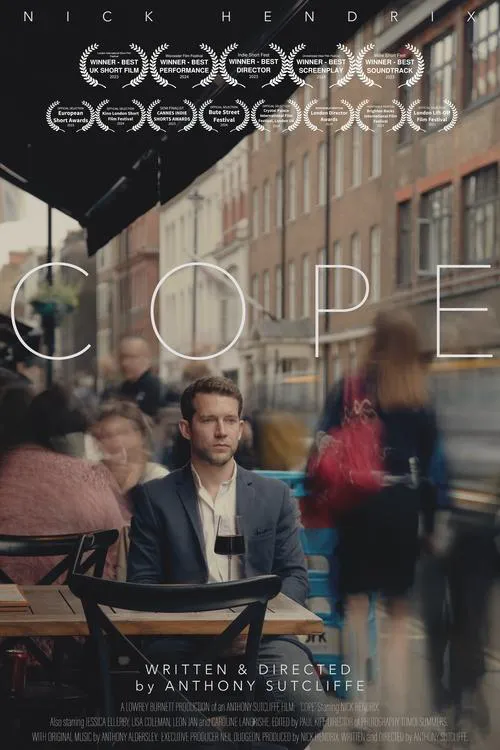The Genesis of ‘Cope’: A Deep Dive into Mortality, Meaning, and the Human Spirit

“Cope” is far more than just a psychological drama; it’s an immersive cinematic journey into the fragile essence of human existence, daring audiences to confront profound questions of mortality, relationships, and what it truly means to live a meaningful life. Through the intimate lens of Liam’s final six weeks, the film meticulously crafts a narrative that is both heartbreakingly personal and universally resonant. But how did this emotionally charged vision come to fruition on screen? Let’s take a look behind the curtain.
Conception: Unpacking the “Coping” Mechanism
The very title, “Cope,” serves as the bedrock of the film’s conceptual framework. From its earliest ideas, the filmmakers were driven by a desire to explore the verb’s multifaceted meaning within the inescapable context of impending death. The core challenge in pre-production was to effectively portray Liam’s internal struggle — his painful metamorphosis from the initial shock of a terminal diagnosis to a profound re-evaluation of his life, relationships, and fundamental identity. The original script aimed to strip away the trivialities of everyday life, leaving only the raw, unfiltered emotions that unfurl when confronted with a finite deadline.
Bringing this highly introspective piece to life required a meticulous and delicate balance. The director and screenwriters collaborated closely to ensure that Liam’s psychological progression felt utterly authentic, carefully sidestepping any descent into melodrama. The creative decision to prominently feature Liam’s inner monologue was pivotal, offering the audience an unfiltered window into his tortured soul — a bold choice that demanded exceptional writing and a nuanced voice-over performance. This integral element was painstakingly refined during the development phase to ensure it consistently added emotional depth without creating unnecessary distance between the character and the viewer.
Weaving the Fabric of Reality and Dream
One of “Cope’s” most distinctive stylistic and narrative elements is its ethereal blend of reality and a dreamlike state. This artistic leaning was much more than a mere aesthetic choice; it served as a crucial symbolic and psychological device, mirroring Liam’s increasingly fluid perception of time and his dislocated sense of self as his life slowly ebbed away. The cinematographers and production designers worked in close concert, dedicated to creating a visual language that subtly shifted throughout the film. They employed precise use of lighting, evocative soundscapes, and deliberate set design to immerse the audience fully into Liam’s subjective experience. This sophisticated approach was specifically designed to reflect the surreal and disorienting passage of time that a person facing their end might encounter, where every fleeting second paradoxically feels both precious and drawn out.
The Demands of Emotional Authenticity: Performances Under Pressure
At its core, “Cope” pulsates with the complex and often strained relationship between Liam and his partner, Sarah. Portraying this intimate dance of love, shared grief, and unspoken fears placed immense emotional demands on the lead actors. They were tasked with the challenging roles of bringing to life a couple pushed to their absolute psychological and emotional limits, navigating past regrets that constantly collided with present pain and the looming specter of future emptiness.
On set, intense workshops and dedicated rehearsal periods were essential in building the raw, authentic, and often strained chemistry required for their characters. This rigorous preparation ensured that every subtle nuance of their struggle — from Sarah’s quiet, almost stoic fortitude to Liam’s desperate, often misguided attempts to atone for past wrongs — resonated deeply and genuinely with the audience. Beyond the central couple, the film also carefully explores the sometimes awkward or superficial attempts of friends and family to offer support, unflinchingly highlighting the profound isolation that can frequently accompany terminal illness. This aspect, early in the production, was decided to be portrayed with an honest, unvarnished realism, rather than sugar-coating the difficult truths of human connection under extreme duress.
Asking the Ultimate Question: What Makes a “Good Person”?
Perhaps the most challenging, yet ultimately rewarding, aspect of bringing “Cope” to the screen was the unflinching exploration of its central philosophical question: What truly defines a ‘good person’? Liam’s increasingly self-imposed isolation ultimately becomes his unlikely pathway to profound self-discovery, where he slowly learns to embody traits like responsibility, genuine compassion, and earnest empathy — qualities he tragically recognizes were sorely lacking for much of his life.
The entire creative team was committed to depicting this transformation not as some sudden, miraculous epiphany, but as a painstaking, often agonizing, and incremental re-evaluation brought on by the ultimate, inescapable deadline. This powerful thematic core demanded both immense sensitivity and bold, uncompromising storytelling to present a journey that is, in its raw honesty, ultimately uplifting. “Cope” bravely invites viewers to confront and question their own values and priorities, leaving them to ponder these existential inquiries long after the final credits cease to roll.